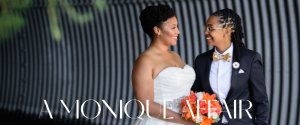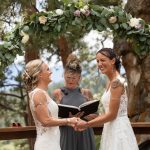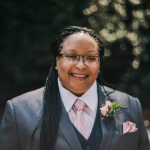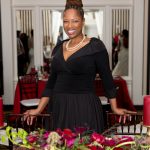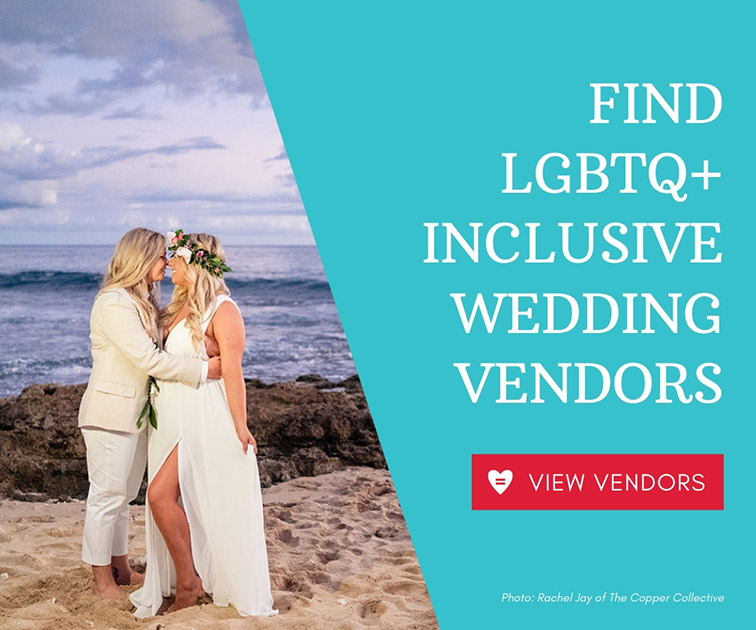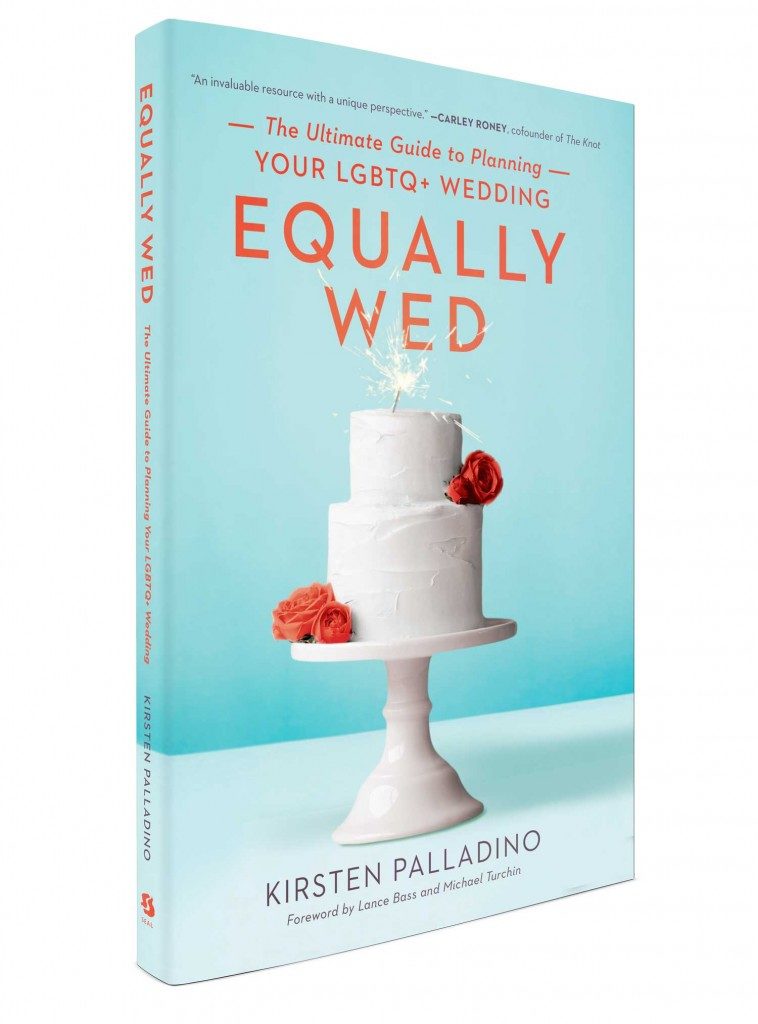Is marriage equality relevant to radical queer politics? Bird Pilatsky challenges the notion that engaging with norms of marriage is regressive and anti-queer.
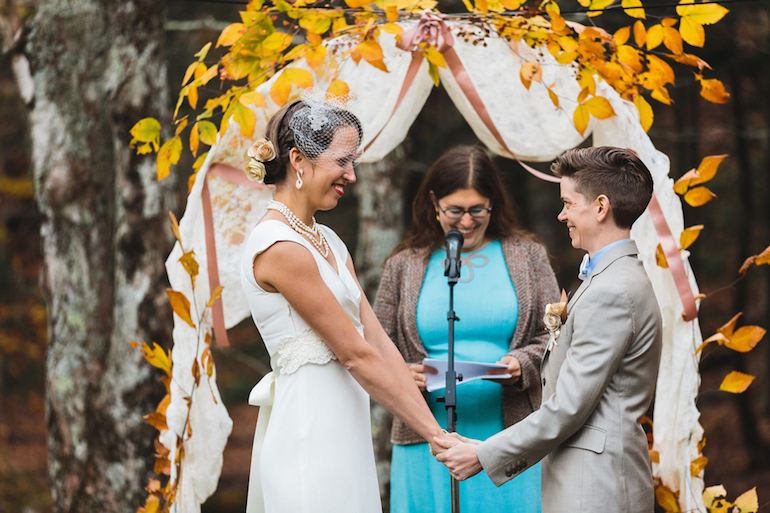
Susan and Jana’s rustic Catskill Mountain wedding. See more from their gorgeous marriage here. Photo: Hudson River Photographer
I always swore I wasn’t going to get married. At first, this may have been compensatory—when I was first coming out in 2005, marriage equality hadn’t reached my home state of New York (or many states at all). There seemed to be no point in aspiring to a social and political status that was clearly a long way off, that still had an extended fight ahead of it. When I left for college in 2008, headed in fact to Massachusetts where marriage was legal, my position remained unchanged. The marriage fight was going strong in several states by then, but I just wasn’t personally interested. At the same time, I believed strongly that marriage should be legal, and this was also the prevailing opinion among my classmates. Attending an historic Seven Sisters school, throughout my first year the marriage question seemed sacrosanct; certainly my classmates had a range of political priorities, but gay marriage typically featured prominently among them.
It was during my sophomore year that I began to see a shift in the situation. Slowly, I discovered that a significant number of my classmates thought that gay marriage was the wrong priority for left, or more often radical, politics. Moreover, the individuals who thought this were overwhelmingly queer identified and they all spoke intelligently and incisively about the complexity of contemporary politics, as well as about the influence of historic queer culture on their political positions. Radical queerness, it became clear to me, emphasized a real state of difference from straight society and even from much of lesbian and gay culture; marriage meant assimilation, and that was apparently unacceptable to these classmates. This division came to exemplify for me the difference between being gay and being queer, and in the course of sophomore year, I had come to understand myself as most aligned with the flexible, anti-mainstream politics of queerness.
The nuances that separate radical queer politics and the average left-leaning position that advocates marriage equality are about more than assimilation to straight society. There are deep-seated class and race concerns that inflect marriage politics, and a strong sense among many young queers that marriage is a white, middle class concern. But it isn’t that simple. I know from experience that the line between these two contingents is porous and constantly shifting. I know because just a few years ago I was a radical queer. Today I am engaged, living in a state that doesn’t yet permit gay marriage, and slowly planning for a wedding to take place nearly 1,000 miles away. Living this shift has left me wondering: Is there a way in which mainstream gay politics and radical queer agitation can engage each other with less acrimony? Is there a way to meet in the middle without leaving people behind?
Leaving individuals with less privilege behind is one of the major concerns of the radical queer anti-marriage position. To fight for marriage equality, in this view, is to seek recognition from a hostile state that has built itself up on the backs of the lower class, people of color, and nonconformist queer folks, among others. If we are fighting for marriage, what does that mean for demographics with lower rates of marriage overall, such as African American women, who are quickly outpacing men of the same race in academic and professional achievement and who frequently find themselves as the heads of households, raising children without a second parent? How does attaining marriage help those without health insurance or those facing deportation? The radical arm of the movement as I know it greatly prioritizes these issues, as well as transgender rights and anti-trans violence, and homelessness and suicide (particularly on the part of queer youth) over marriage in the hierarchy of political goals.
I would never declare any of the above-stated “radical” goals as unworthy of political attention. In fact, all of these issues remain deeply important to me. However, progressive left politics does have answers to some of these concerns, and they have been duly noted time and time again. As progressives point out, marriage means that in cases where one partner has employer-issued health insurance, the other can legally be covered. (This is, of course, of less concern with the passing of the Affordable Care Act, but the issue is still alive and contentious, particularly from the perspective of class and access.) Similarly, gay and lesbian couples in which one partner is not a citizen, with the achievement of marriage equality, will be able to take steps towards citizenship and will no longer have to worry about being separated due to unequal legal standing. The progressive position consistently raises these points to note the ways in which marriage does in fact address concerns articulated by radical queers, but for many within the movement these approaches do not go far enough. What about homeless youth? What about transphobic and homophobic violence and suicide? Marriage doesn’t seem like the answer to those issues, and I’m willing to concede that it’s not. But I also would contend that they do have more bearing on each other than the queer position tends to admit.
In what ways can marriage equality affect these seemingly disparate issues? To some degree, the interrelationship I suggest here hinges on this question of assimilation, or the “we’re just like you” argument. Marriage equality is, at its core, about creating equality under the law, but it also is very much about social equality, the kind born out of a sense of community and commonality among neighbors and associates. In this sense, then, it is also about stigma, specifically the reduction of stigma. If films like The Kids Are Alright and shows such as “The New Normal” and “Orange is the New Black” seem to indicate some greater amount of acceptance for queer folks in the media, can we move from these nodes of inclusion to see greater real life acceptance? I would say yes, but only if we account for that ever-maligned thing called assimilation. The queer people featured on screens big and small all partake to some degree in the tropes of normalcy: good looks, family values, and the like. “Orange is the New Black” may be unique in that it deals in class issues, but ultimately beautiful Sophia, who wants little more than the continued love of her wife and son, is more embraced as a character than the highly visibly queer “Big Boo,” who is written as unattractive and predatory. Normalcy counts. Radical separatism is threatening. It’s a simple equation, at least in media portrayals, as well as on the battlegrounds for acceptance commonly known as the family dinner table and the high school hallway.
While television and film may not be the best models for queer potential, I do consider them a means for transformation. Positive representations of lesbian and gay individuals on television or in movies have the potential to reduce stigma. Representation produces possibilities, stating definitively that young queer people can lead successful lives. This makes a world of difference, both for young people who are able to develop a more positive self-image through uplifting representation, and also for their families and friends. Stigma plays a huge role in the high number of homeless and suicidal queer youth. Being seen and understood is a first-line prophylactic against these struggles.
If a sense of normalcy is so valuable, what precisely is the problem with assimilation from the radical queer perspective? Certainly there have been arguments for normalcy since the beginning of the queer movement—the Mattachine Society was straight-laced and professional, one of the earliest groups to campaign for gay rights under a civil rights model. (One founder, Harry Hay, ultimately defected to help form the Radical Faeries, a group more decidedly in the queer column of the movement that continues today.) Radical queerness resists assimilation because of an interest in liberation over rights. As many remind me during pride month (as though I’ve forgotten), Stonewall was a riot, and that was the case for a reason: Bar raids were dangerous, oppressive, and intentionally shaming. People in the closet found their names published in the papers the morning after a raid and these individuals were frequently shunned by neighbors and colleagues, often losing their jobs. This overwhelming discrimination did not create goodwill between straight individuals and their gay friends and neighbors.
In response, then, some queer people have historically embraced what was labeled “perversion” and even classified as a mental illness, seeking out a lifestyle that would emphasize their legal status as sodomites and social perception as freaks. Alienating straight society was, and continues to be, a powerful and empowering result—and I won’t pretend that I didn’t once aspire to a politics that would make my family squirm. Whereas rights meant becoming like the majority, liberation meant freedom from the tyranny of that majority, from patriarchy, the gender binary, and the nuclear family. Assimilation, then, can seem like spitting on the ancestors: Why did they work so hard to get homosexuality removed from the DSM, to legalize queer sex practices, and to end the constant harassment of our community by the police? Why do we want the sanctioning and approval of the state to determine the worth of our relationships, when the state is an historic enemy that we have more frequently hoped to keep at a distance? This tension is where I perceive significant misunderstandings between mainstream gays and lesbians and radical queers.
Understanding marriage as a focal institution of the state is not inaccurate, but I think it’s important to be somewhat less cynical about the gains that have been made in the last 50 years. The declassification of homosexuality as a mental illness and the overturning of the remaining sodomy laws in Lawrence v. Texas are both indications that the state has become more expansive, but not necessarily in a way that is about self-benefit and increased purview. The DSM is not a function of the state and the Supreme Court is often not in clear alignment with its sibling branches. Furthermore, gay marriage, though backed by decisions written by Justice Kennedy, has been turning over state by state, rather than through a singular federal motion. If the government really wanted to more closely monitor and police queerness, marriage equality would have reached its arm across the country by now. No, the successes of marriage equality do not reflect a state-based move toward queer inclusion. I truly believe this is grassroots at its finest. Our neighbors and families are finding room for us at the table, and the seating options can and will include more than just marriage if we all pause to think about how complex a system marriage is, both personally and politically.
Radical queers are right to worry about people being left behind in the push for marriage equality, but I also think they are mistaken in their conviction that marriage is an entirely anti-queer goal. Our marriages don’t have to be like those of our parents. We can queer the institution. Moreover, I’m not entirely convinced, as an individual who has made the transition away from radicalism, that the abolition of marriage as a state institution is a bad goal. Rather, I believe that as time goes on and we make the press for more diverse marriage practices (because I also see a place for marriage equality to eventually include marriage between more than two individuals, for example), that marriage will become less coherent. As marriages begin to proliferate in form, the logic behind them has the potential to weaken. In that sense, citing the anti-marriage equality argument, gay marriage perhaps does weaken the institution of marriage. But the base institution is inherently patriarchal, and I for one would want to weaken that anyway, if we can’t do away with it at this juncture.
My conversion away from radical queerness is in some ways about weakening the patriarchal formation of marriage, but it is more importantly about a combination of love and inclusion. My partner is the first person I ever found myself envisioning building a life with, a fact that I meditated quietly on while we dated in college, both of us then outwardly swearing our allegiance to radicalism. Then there was the summer my partner worked for Equality Maine, canvassing door-to-door for marriage. Having a young queer person turn up on your doorstep and hearing their story was transformative for some initially anti-marriage equality individuals. Hearing my partner’s stories about this experience left me to wonder whether doing something as heartfelt as marrying the person I love could have far-reaching ramifications for acceptance on a wider scale. If this could change the material conditions of life for young LGBT people, I thought, maybe marriage has more radical potential than it first seemed. Maybe marriage could also be a way of honoring previous generations of queer activists.
I have friends who may think that I became a traitor to the movement the day I got engaged, but ultimately I think we are all stronger together, stronger when we are thinking creatively about marriage and expanding the institution, rather than dismissing it entirely. We are masters of the act of reclaiming, taking queer back from the vocabularies of those who despise us and taking to the streets for events such as Dyke March. We can do the same thing with marriage; we can stake a new claim on old territory. Each day my partner and I renegotiate what it means to be queer, monogamous, and moving toward marriage. Our lives are only one version of the endless possibilities I think queer ingenuity can create within and beyond marriage, possibilities that are at least as queer as anything I imagined in my anti-marriage days.

Bird Pilatsky is a doctoral fellow in Women’s, Gender and Sexuality Studies at Emory University and an alumna of Smith College. Her writing has been featured in Broad Magazine, at xoJane, and on The Rose and Chestnut. For more, visit her blog.
This essay was first published in Stir Journal, and it’s reprinted with written permission from the editor.






